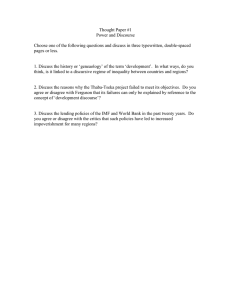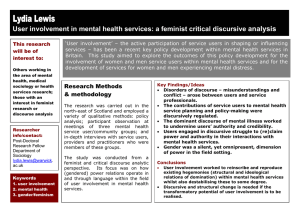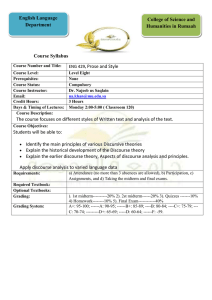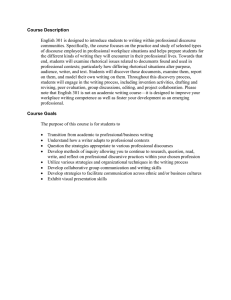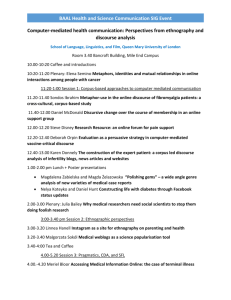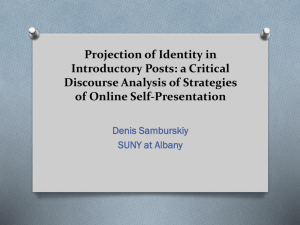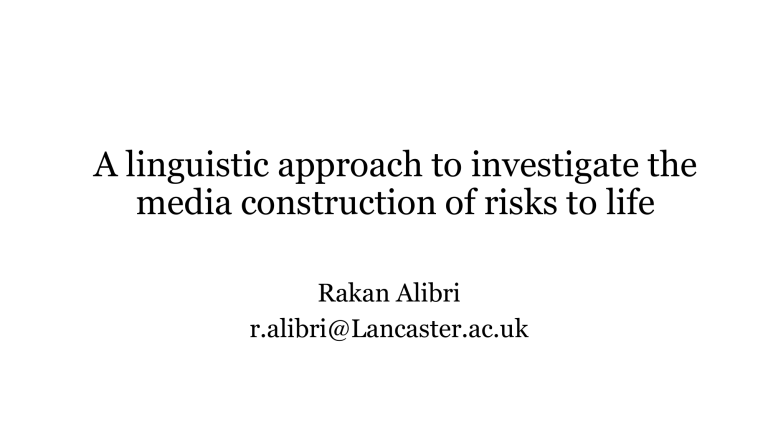
A linguistic approach to investigate the media construction of risks to life Rakan Alibri r.alibri@Lancaster.ac.uk Presentation structure • Risk research • Critical Discourse Studies • Corpus linguistics • Background to risks to life study • Discursive strategies of risk construction • Dramatisation and naturalization • (Im)personalisation • Blame and responsibility • Risk management • Closing remarks Risk research • Risk as a mathematical concept (e.g., engineering or economics) • Risk perception (risk as subjective and socially construct) Cognitive psychology (e.g., the psychometric paradigm) Sociological approaches Governmentality) (Cultural Theory, Social amplification of risk framework (SARF) Risk communication Risk reporting Risk Society, and • SARF: “While hazards are real enough, our knowledge of them can only ever be socially constructed” (Pidgeon & Henwood, 2010: 3) • The research community acknowledged the role of media in risk perception (e.g., Wahlberg & Sjoberg, 2000) and realised that risk is complex and requires an interdisciplinary approach to investigate it (e.g., Kasperson et al., 1988; Zinn & Müller, 2021). • How do the media use language to discursively construct risk and how does that relate to society? Critical Discourse Studies (CDS) • CDS is interested in “studying social phenomena which are necessarily complex and thus require a multidisciplinary and multi-methodical approach” (Wodak & Meyer, 2016, p. ) • “CDS see discourse – language use in speech and writing – as a form of ‘social practice’. Describing discourse as social practice implies a dialectical relationship between a particular discursive event and the situation(s), institution(s), and social structure(s), which frame it: The discursive event is shaped by them, but it also shapes them.” (Fairclough & Wodak, 1997, p. 258) • Being critical requires “unveiling and challenging taken-for-granted assumptions about language” and society, and recognising that discourse is “a potentially powerful agent in social change” (Mautner, 2016, p. 157). Discourse as text, interaction, and context (Fairclough, 1989: 25) Corpus linguistics • Corpus Linguistics (CL) is “the study of language based on examples of real life language use” (McEnery & Wilson, 1996, p. 1) • CL uses computers to present large numbers of texts (corpus/corpora) in an organised way to help analysts detect patterns. • CL methods/techniques are frequency, concordance, collocation, clusters, and keywords. • A corpus must be machine-readable, authentic, sampled, and representative (for more details on how to build a corpus see Mautner, 2016; Baker, 2018). Background to risks to life study • The construction of risks to life in the British newspapers • Investigation of risks to life with different media coverage and risk levels (i.e., likelihood of occurrence and number of deaths) by focusing on risk events, death, and social actors. • Corpora • Terror-attack corpus (4.3 million words) • Road-accident corpus (1.7 million words) • Heart-attack corpus (4.3 million words) • Research question • How did the British newspapers use language to discursively construct the risks to life between 2017 and 2020? Discursive strategies • Strategy is a “more or less intentional plan of practice (including discursive practices) adopted to achieve a particular social, political, psychological, or linguistic goal” (Reisigl & Wodak, 2016, p. 33). • The discursive strategies employed are dramatisation and naturalisation, (im)personalisation, blame / responsibility, and risk management. • They overlap and appear in all three corpora but with different degrees, and each strategy has an inverse. Dramatisation • A set of discursive practices used by the media to describe risk events, including narratives, emotional / dramatic language, sensationalisation, metaphors, and (direct) quotations. • Narratives are typically the core of dramatisation and help readers comprehend the world, “making the abstract concrete, the complex more manageable, and rendering matters ‘real’” (Selbin, 2010, p. 30). • Realisation in discourse • Modifiers (e.g., adjectives such as ) • Verbs (e.g., kill or murder) • Direct quotation of those witnessing the events and relatives of victims Naturalisation • Where newspapers represent events as natural and familiar in normal life. • Realisation in discourse • Verbs (e.g., happen or occur) • Representing the risk as a natural phenomenon (e.g., occurring repeatedly using phrases such as every year) • Mentioning death in passing Personalisation and impersonalisation • According to Van Leeuwen (1996), personalisation represents social actors as humans, while impersonalisation represents them as abstraction or objectivation. • Personalisation relates to discursive practices newspapers use to represent risk events, death, and social actors so as to increase audience relevance. • Personalisation as a news value (Bell, 1991; Johnson-Cartee, 2004) • Realisation in discourse • Personalisation: Naming victims, perpetrators, locations, and risk events • Impersonalisation: scientific and statistical reports, nominalisation (e.g., death instead of die) Blame and responsibility • Blame in risk reporting occurs when the media negatively judge or apportion responsibility for a fault or wrongdoing that occurred in the past. • Blame can be direct or indirect, or the media may choose to avoid blame. • Responsibility is not necessarily related to wrongdoing or time restricted, referring (often neutrally) to organisations or individuals who take responsibility for some matters, or directly or indirectly allocate it to those responsible for themselves or others. • Realisation in discourse • Active structure and personalisation to express blame • Passive structure, nominalisation, and impersonalisation expressing blame to avoid Risk management • Risk management refers to ways the media construct how risks are managed and their controllability. • Realisation in discourse • The use of legitimisation strategies • Voices of authority (Van Leeuwen, 2007) or expertise (Reyes, 2011) • e.g., government statements and scientific reports • Appeals to emotion, especially fear, (Reyes, 2011) to construct the risk as unknown and uncontrollable • Governmental management: providing funds and/or regulating behaviour • Verbs indicating changes in risk (e.g., deaths expressed in numbers as increasing or decreasing) • Negation after alarming messages Closing remarks • The approach allows examining thousands of articles and identify linguistic patterns and discursive practices, interpreting the production and interpretation processes, and explaining how they relate to the social context. • The discursive strategies in risk reporting are by no means exhaustive, and the linguistic realisations are only selected examples found in the analysis. • These can potentially be linked to how media amplify or attenuate risks in society, a consequence of media language use. • The risks to life are from different domains (i.e., violence, accidental death, and health), which may demonstrate a wide range of applications, and future research may use the methodology or discursive strategies to examine other risks
